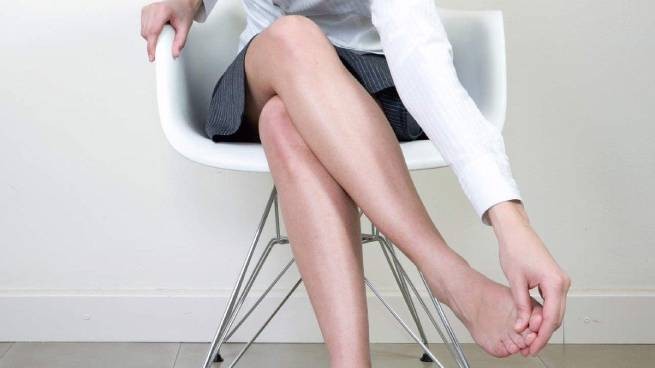Even absolutely healthy people can experience all the “delights” of leg swelling at least once in their lives. About causes, symptoms, treatment and prevention.
Swelling of the feet is an unattractive phenomenon that causes some discomfort: your favorite shoes flatly refuse to serve faithfully, and swelling of the feet causes understandable concerns. Undoubtedly, you can blame everything on the herring you ate the day before and the liters of water or beer you drank, but if swelling of the feet constantly occurs, you should look for a reliable explanation for this fact.
Why do my legs swell – a one-time problem?
Even without health problems, you can experience swelling of the legs. The reason may be:
- a tiring plane ride;
- long walking;
- shoes that are too tight;
- drinking a large amount of liquid;
- pregnancy;
- disruption of microcirculatory processes and accumulation of fluid in tissues due to heat.
Evidence of serious illness
Most often, sadly, swelling of the legs indicates the presence of various diseases.
Cardiac swelling of the legs. The culprit is usually heart failure. Edema can appear with various heart defects, vascular aneurysm, after myocardial infarction. As a rule, they are symmetrical, starting with swelling of the leg at the ankle and spreading upward to the thigh and lower leg. The skin is soft and cold to the touch, the skin has a bluish tint and is stretched. As night approaches, cardiac swelling of the legs becomes even more noticeable; when you press on them with a finger, a hole remains for a long time. If a person with such edema is forced to constantly stay in bed, they decrease in the legs, but “move” to the lumbar region.
Impaired lymphatic drainage. Lymphedema is an increasing swelling of the tissues of the affected area, most often the lower extremities, due to impaired outflow of fluid through the lymphatic vessels. It is accompanied by general weakness, a feeling of heaviness and unpleasant bloating in the limb (usually one). Edema occurs when deep vessels are involved in the pathological process. First, changes are noticeable in the ankle joint, gradually the swelling rises higher. Swelling of the legs is most noticeable in the evening, and after an overnight rest it does not disappear. The last stage of the disease is elephantiasis.
Kidney problems. Impaired renal filtration leads to persistent fluid retention and, as a consequence, the appearance of edema. At first they are noticeable under the eyes, then, against the background of severe pain in the lumbar region, the legs and arms swell. Swelling is most pronounced in the morning, becoming less in the evening.
Violation of venous outflow
In various diseases, edema has its own characteristic features. Violation of venous outflow has special manifestations for each of them:
- varicose veins – the onset of the disease is characterized by swelling of the feet and legs, more pronounced in the evening;
- thrombophlebitis – swelling of the left leg and swelling of the right leg in the ankle area are different, asymmetry is clearly observed. Associated symptoms are pain in the calf muscles, local fever and some soreness in the lower legs;
- postthrombophlebitic syndrome – significant swelling on the legs, less pronounced – on the hips. Usually present only on one side – swelling of the right leg or left. In the evening, the manifestations increase, and after a night's rest they become less noticeable;
- inferior vena cava syndrome – severe swelling of the legs spreads to the buttocks, abdominal wall, and genitals. An extremely unpleasant additional symptom is numerous trophic ulcers on the legs.
When legs swell due to neurological ailments
The causes of edema may be neurological diseases, polio, or stroke with paralysis of the lower extremities. Increased capillary permeability causes moderate swelling of the legs. Similar phenomena can be observed in diseases of the endocrine system.
Traumatic injuries
Swelling is a frequent accompaniment of various injuries; it accompanies bruises, dislocations and fractures for several days. Gradually disappears during the treatment of the underlying disease.
Edema in old age
It is worthwhile to dwell separately on the reasons why there is swelling of the legs in older people. This is a natural and fairly common phenomenon – age-related changes in the body, alas, are irreversible. Due to a slowdown in metabolism and insufficient functioning of internal organs, tissues accumulate fluid, resulting in swelling of the legs, arms, and face. However, these symptoms can also signal serious problems in the body and the presence of various diseases. For example, swelling of the leg in the ankles may indicate heart failure, and swelling of the left or just the right leg may indicate deep vein thrombosis. Cirrhosis of the liver or lung disease can also cause leg swelling.
Gender characteristics
Venous insufficiency is the most common cause of leg swelling in men. Representatives of strong bodies sometimes choose a profession associated with increased physical activity and heavy lifting. In addition, intense sports training can lead to fluid stagnation, against the background of profuse sweating and insufficient fluid replenishment. Swelling is also possible due to their taste preferences – fatty and spicy foods, excess salt. In an effort to get rid of extra pounds, some subject themselves to the merciless torment of diets, and in this case, swelling occurs due to the lack of protein entering the body.
In the fair half of humanity, swelling of the legs is often associated with hormonal changes. It happens:
- during menopause;
- before menstruation;
- during pregnancy and after childbirth.
Usually these are fairly normal physiological phenomena that do not require special treatment. If swelling is constant or bothers you too often, you should consult a doctor.
Diagnostic methods
The causes of leg swelling, as is clear from the above, can be very diverse. If swelling of the legs in the ankles or feet is a short-term phenomenon associated with heat or an abundance of liquid drunk, a visit to the doctor is not necessary. If you have accompanying symptoms, especially signs of allergies, shortness of breath, difficulty breathing or pain, you cannot do without a visit to the doctor. You should not diagnose yourself and resort to diuretics. In some cases, this is fraught with side effects and aggravation of the existing problem.
If you want to know why your legs swell, your doctor will tell you the reasons. After a visual examination and detailed familiarization with the circumstances of the occurrence of unpleasant symptoms, the doctor, depending on the need, prescribes certain studies:
- blood tests – complete and for clotting;
- ultrasound examination of blood vessels, pelvic organs, and abdominal cavity;
- electrocardiogram;
- checking hormone levels;
- radiography;
- tomography and other studies important for diagnosis.
If necessary, you will need to consult other specialists – a cardiologist, gynecologist, endocrinologist, nephrologist, angiologist or phlebologist.
Any diagnosis takes some time, and swelling of the legs makes life much more difficult. Some general methods to alleviate the condition and reduce swelling, which cannot cause harm, can be tried already at this stage. Attention! Do not get carried away with diuretics and other medications if the cause of edema has not yet been established!
Treatment of external manifestations:
- Limit salt intake.
- The total amount of liquid drunk per day should not exceed 2-2.5 liters. It is advisable not to drink at night.
- Water procedures are an excellent way to dilate blood vessels and reduce swelling. Bathing and swimming in a pool or pond, contrast showers and simply foot baths with mineral water, essential oils, sea salt. A contrast shower helps a lot.
- Swelling decreases after resting in a horizontal position. You need to place a cushion or pad under the legs, raising them 35-40 degrees above the level of the body.
- A light massage helps remove or reduce swelling. Movements should be directed from bottom to top.
- Simple gymnastic exercises – walking on tiptoes, rolling a ball on the floor with your feet, bending and straightening your fingers, rotating your feet.
Treatment is prescribed by the doctor
After successful diagnosis, the doctor offers comprehensive treatment for the underlying disease; its successful therapy will help eliminate annoying swelling. Depending on the reason that caused them, the following methods are usually used:
- special diet – most often with limited salt and water;
- compression underwear – stockings, knee socks and tights. Attention! Preventive compression hosiery can and should be used by everyone, but the doctor selects therapeutic underwear depending on the indications individually and can only be purchased at a pharmacy;
- various ointments and gels to relieve inflammation, improve blood circulation, eliminate microthrombi, strengthen the walls of capillaries and veins;
- diuretics – only as prescribed by a doctor and in courses. Constant use of “harmless herbs” can cause dehydration, sudden increases in blood pressure and a host of other side effects;
- hardware lymphatic drainage massage not only successfully helps when the legs are swollen – treatment of this kind restores the former attractiveness of the legs, relieves fatigue, and restores lymph flow. However, this method of treating edema has many contraindications – various skin diseases, pregnancy, cancer, kidney failure, vascular lesions in diabetes;
- Cardiac edema of the legs can only be treated comprehensively, using drugs that increase myocardial contractility, drugs that reduce vascular tone, and medications that reduce the load on the heart.
Swelling of the legs often indicates very serious ailments. Therefore, experts never tire of warning again and again: if your legs swell, treatment should be prescribed exclusively by a doctor, even if these are traditional medicine recipes.
Treatment with folk remedies
The main focus when the legs are swollen should be drug treatment. However, other methods are also important in improving the condition. Treatment with folk remedies will help you quickly return to a full life, remove cosmetic defects, and successfully remove excess fluid from the body. Consult your doctor and choose the method that suits you:
- One tablespoon of ordinary garden parsley should be poured with two glasses of boiling water. Drink little by little throughout the day:
- Add lemon and cucumber juice to half a glass of fresh carrot juice. Divide the mixture three times, adding water as desired;
- Pour boiling water over 50 g of dried chamomile flowers, leave and use for foot baths.
Prevention of edema
Treatment with folk remedies is a good support. But it’s even better to prevent your body from reaching a state during which your legs and arms swell and a visit to the doctor is necessary. The best treatment is prevention.
Preventive measures for leg swelling – expert advice:
- vitamins B, C, E improve blood circulation and perfectly strengthen blood vessels, do not forget about taking them;
- movement is life, and regular walking will reliably protect against swelling;
- do not be lazy to place a small pillow under your feet while you rest;
- cross-legged posture is the surest road to varicose veins;
- When sitting for long periods of time, take short breaks every half hour;
- watch your weight;
- tight tights and tight shoes interfere with normal blood flow;
- high heels – not for long hours of use, do not abuse your legs;
- if possible, give your feet periodic rest – take off your shoes for a few minutes, move your toes, massage your feet;
- smoking or beautiful and healthy legs – the choice is yours.
Take care of your legs, pay attention to them, and they will remain healthy and attractive for a long time.







More Stories
Tariffs for "green electricity": detailed prices by suppliers for May
Child Benefit: Find out when the application platform will be temporarily closed
Greek Police: "Pyrotechnics for Easter are not toys for you"